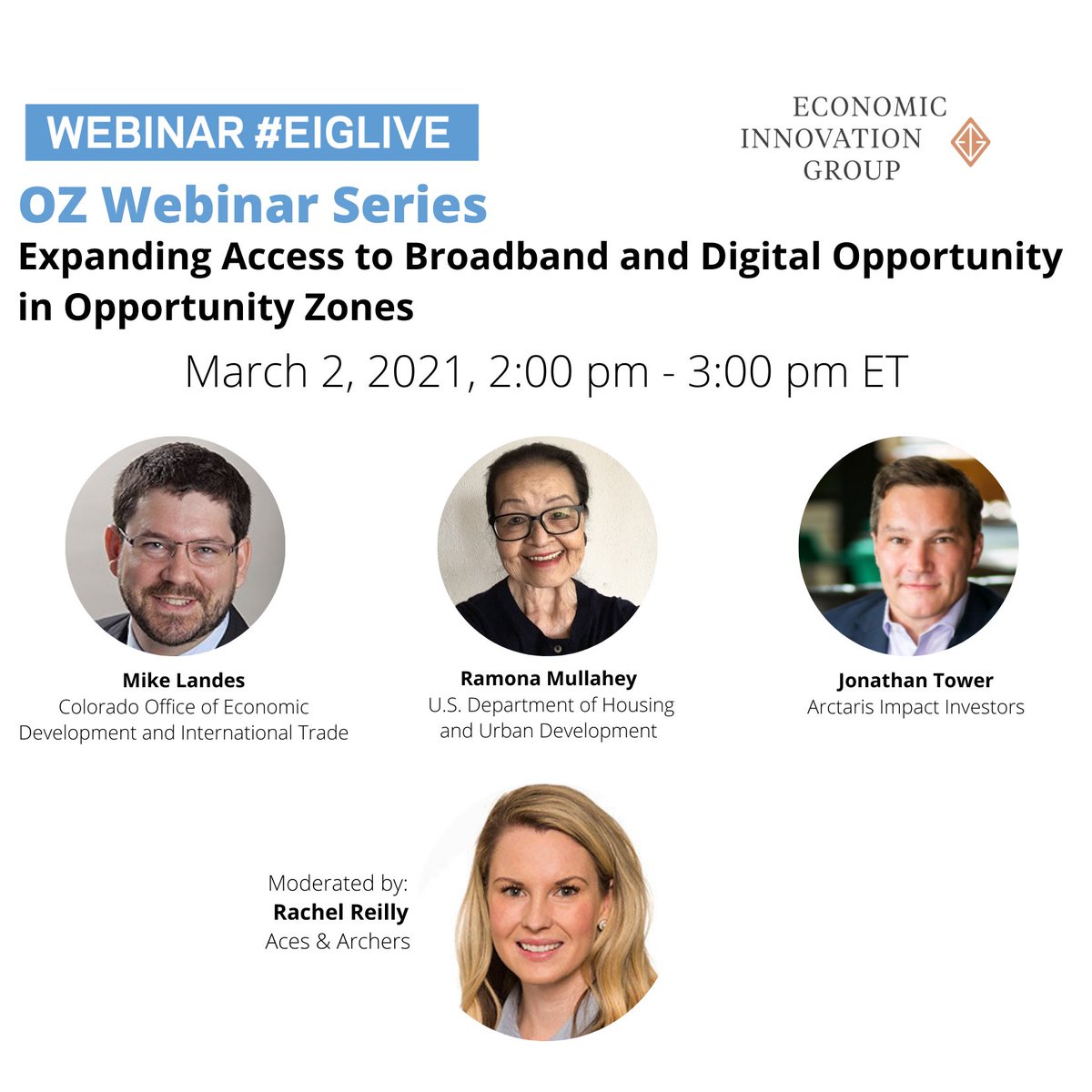By Rachel Reilly
On March 2nd, the Economic Innovation Group (EIG) hosted a webinar to discuss strategies for expanding broadband and digital access in Opportunity Zones (OZ). Guest speakers shared insights on the importance of closing the digital divide in OZs, the challenges of expanding broadband in these communities, and how OZ equity is being used to do so.
View presentation slides, a recording of the webinar, and EIG’s key takeaways for more information.
Key Takeaways
At the beginning of the webinar, EIG’s Director of Policy and Coalitions, Catherine Lyons, provided an overview of new OZ resources and field updates, including:
- EIG’s Opportunity Zones: State of the Marketplace report
- A comment letter submitted by EIG’s OZ Coalition in response to the Federal Reserve Bank’s proposed reforms to the Community Reinvestment Act
- The introduction of the 2021 Opportunity Zones Extension Act
Rachel Reilly from Aces & Archers then framed the conversation by describing the importance of digital opportunity in OZs and highlighting current efforts by public and private stakeholders to address limited access to broadband.
- On average, 27 percent of OZ residents live in a home without access to a computer and broadband internet, disconnecting them from educational and economic opportunity in an increasingly digital world.
- Closing the digital divide has become a national priority, and increased public-sector resources have coincided with private-sector innovation aimed at digital advancement.
- The Consolidated Appropriations Act of 2021 included $7 billion in broadband relief and infrastructure funds for low-income, minority, and tribal communities and established the Office of Minority Broadband Initiatives which has a mandate to pursue public-private financing solutions in priority communities, including OZs.
- Funding from the CARES Act has been deployed to establish or enhance state-level broadband expansion programs, and in general, states have prioritized: increasing access to online learning, supporting telehealth services, expanding public Wi-Fi access points, and investing in residential broadband infrastructure.
- Private-sector efforts in OZs have centered underserved residents and entrepreneurs in economic development strategies grounded in digital advancement. Examples include a place-based strategy in Memphis, TN, focused on minority entrepreneurship and expansion of high-speed internet, and an investment thesis focused on digital economic development and innovation campuses in rural communities.
Ramona Mullahey from the U.S. Department of Housing and Urban Development’s (HUD) Honolulu Field Office shared that the expansion of broadband is key to Hawaii’s economic recovery following the COVID-19 pandemic.
- HUD’s ConnectHome Program was a multi-approach initiative to narrow the digital divide for HUD-assisted families, which has since led to the creation of a technical guide called the ConnectHome Playbook and the ConnectHomeUSA expansion program for resources.
- Leaders from more than 200 organizations are working together to address broadband access and digital equity through the recently launched Hawaii Broadband Initiative.
- Hawaii is working in coordination with roadway projects funded by the U.S. Department of Transportation as part of a strategy to deliver wifi service to eight underserved communities.
Mike Landes from the Colorado Office of Economic Development and International Trade then provided insights on the state’s efforts to expand broadband.
- The state has two major funding programs, the Broadband Deployment Fund and the Energy Impact Assistance Fund, to expand broadband access.
- One of the main barriers communities have faced in leveraging OZ financing for broadband expansion is the reluctance of broadband providers to share equity. While some providers may not be interested in sharing equity stake, municipalities that have OZs can leverage the incentive in order to fundraise for infrastructure projects.
- The Colorado Health Foundation is working in partnership with Opportunity Fund manager Arctaris Impact Investors (Arctaris) and the Finance Authority of Maine to invest $60 million in broadband infrastructure located in Colorado OZs. This investment will expand broadband access to 25,000 households, many of which are located in towns with lower than 80 percent broadband coverage.
Jonathan Tower from Arctaris provided more information about the organization’s initiative to increase digital equity in underserved urban and rural communities. Tower noted that the program is driven by Arctaris’ partnerships with private companies, municipalities, and philanthropic organizations.
- The $60 million investment in Colorado will reach communities that lack access to healthcare, and expand their access to telehealth services. Arctaris invested $50 million in OZ equity, and the Colorado Health Foundation provided a 20 percent guarantee. Through this investment program, Arctaris will develop impact and broadband screening criteria to identify broadband infrastructure projects with highest economic impact and probability of success, structure investments, and monitor the impact and economic improvement over the life of the program.
- In Maine, Arctaris made a $10 million OZ investment to improve access to education, employment, and healthcare through the expansion of broadband infrastructure. The Finance Authority of Maine provided a 20 percent anchor guarantee and a below market-rate loan to support this investment program, which will reach more than 9,000 households and small businesses. Through this program, Arctaris will identify an internet service provider, evaluate development across impact and broadband screening criteria, structure investments, and monitor impact and economic improvement over the life of the program.
For more information and to see current OZ activities, visit EIG’s Opportunity Zones page and OZ Activity Map.






